From the moment I arrived in Zurich, Switzerland it was evident that this country is a model of efficiency. It runs like the clockwork for which it is so famous. Two immigration officials met the plane and checked passengers’ passports as we deplaned – there were no immigration forms to fill out. There were no lines at immigration and I was passed through with a second perfunctory examination of my passport. A five minute ride on a fast rail carried me to the luggage retrieval area, where I claimed my bag and headed for customs. Here again there was no form to fill out and I wondered whether the spices I had purchased in Zanzibar had to be declared. I finally found a brochure in a rack on the wall of the corridor leading to customs that explained what had to be declared – virtually nothing other than illegal drugs, weapons, or merchandise for sale! The Swiss are not worried about you bringing foreign currency into the country – their super secret banking laws rather encourage the importation of foreign currency. I was waved through customs without a second glance and followed the signs to the train station.
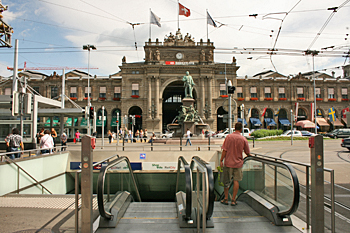
This country runs on its trains. And the trains run PRECISELY on time. Indeed, the trains are so reliable and this is such a small country that there is no demand for inter-city flights. For six Swiss Francs (about $5 U.S.) I purchased a ticket for the train from the airport to the center of Zurich, which runs every half hour. I took the escalator down to the platform. Directional and information signs are everywhere – in German, Italian, French, and in some instances, even in Romanisch, an antique language still spoken by a small portion of the populace in the far south of the country – but not in English. Between my two years of (long unused) college German and my fluent Spanish (which is similar enough to Italian that I can usually figure out written Italian), I managed to find the right platform and board the correct train. Eleven minutes later I arrived at the Hauptbanhoff – the main train station in downtown Zurich. From here you can get to almost any destination in Switzerland. Trains to all the major destinations run every hour or half hour. This suits me because I love to travel without plans. I will just stay in Zurich until I have seen enough, then pack my bag, go back to the train station, look at the big board, and decide where to go next.
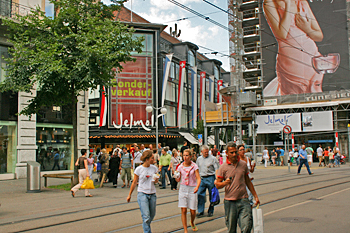
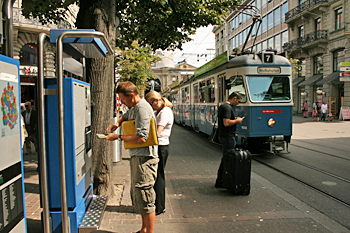
After a brief stop at the tourist information center to pick up a map of the city, I walked the four blocks to my hostel (thank God for rolling suitcases), checked in, dumped my suitcase in the room, and headed out to explore the city. I began with the mile long Banhofstrasse – the famous shopping street that runs from the main railway station to the shores of Lake Zurich. Every known designer is represented here – the stores read like a who’s who of the fashion industry: Ferragamo, Hermes, Cartier, Armani, Louis Vuitton, Benneton, Chanel, Diesel, Swarovski. The Banhofstrasse is a pedestrian mall; only the city’s ubiquitous electric trams travel its length. I am not much of a shopper. In fact, I detest shopping. I was here mostly to experience the life of Zurich. The only thing I really needed was a haircut and I couldn’t find that for less than $100. I wondered how people could afford such extravagant prices, but the sidewalks and streets were crowded with shoppers laden down with purchases.
At the end of the Banhofstrasse I wandered into a weekend flea market. Here hundreds of booths offered everything from old clocks (of course!) to antique guns, to books, to secondhand clothing. Women in big floppy hats and rugged men in stocking caps worked the booths, bargaining hard with customers who, judging by the shopping bags they carried, had likely just spent a month’s salary on some designer item. Something smelled delicious and I followed my nose to the center pavilion, where men in lederhosen bent over grills filled with sizzling bratwurst. No meat for me, though!
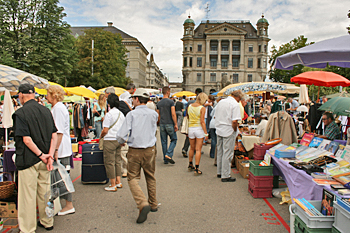


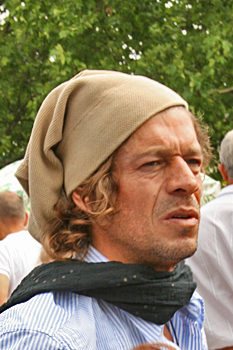
From the flea market I crossed over to the shores of Lake Zurich and walked along its banks to the river, doubling back into the neighborhood between the Banhofstrasse and the river. Here, narrow, winding brick-paved streets are lined with historic buildings hundreds of years old:

I meandered through these streets and alleys, discovering outdoor cafes along the river bank, architecture and art.
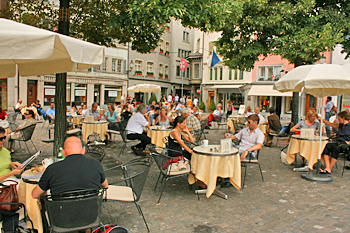
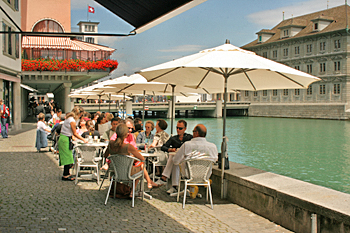
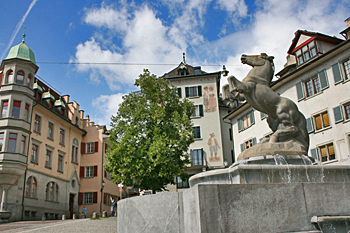
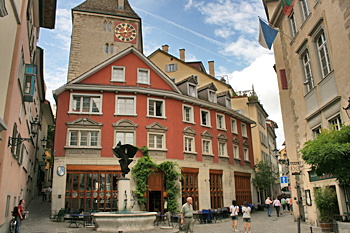
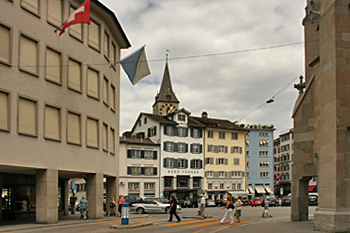
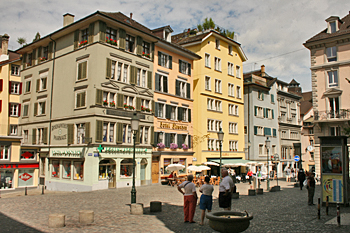
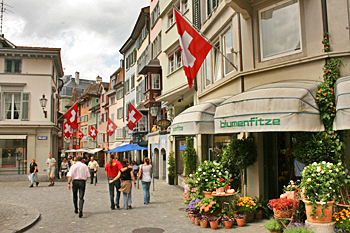
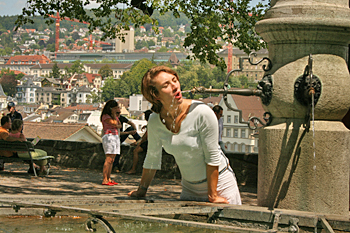
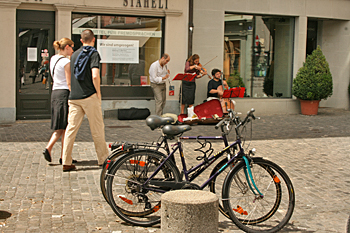
The Swiss love their bicycles. They are allowed on the trains, the electric trams, and the ferries – I even saw people taking them on escalators. Wherever you go you are sure to see racks of bicycles. Sometimes they are just left leaning on a convenient rail or perched against a tree in a convenient flower bed. No one seems to bother them, nor does there seem to be any danger of theft, as many of them were unlocked. In fact, the Swiss are so tied to their bikes that in Zurich – as well as in some other Swiss cities – you can borrow a bike for free for the day!
The most fascinating architecture in Zurich revolves around the beautiful old churches whose steeples dominate the city’s skyline. The clock tower of St. Peter’s Church is Switzerand’s largest.
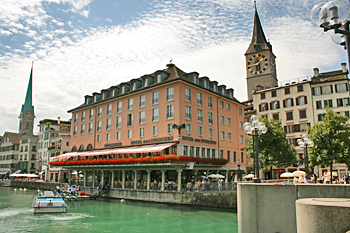
Although it can be seen from many vantage points around town, I particularly liked the view of it looking down the flag-lined Augustinerstrasse:

The Fraumunster Church is famous for its stained glass windows, designed by Marc Chagall:
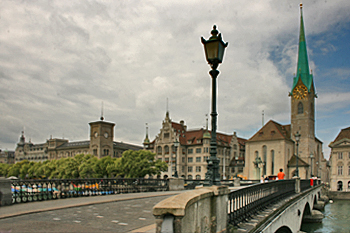

and the twin domed towers of the imposing Grossmunster Church can be seen from far out into the lake:
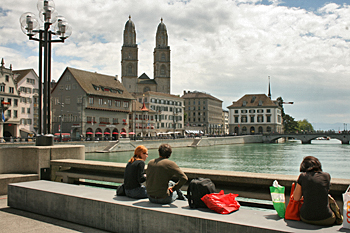
I found one vantage point where both Fraumunster Church and St. Peter’s were reflected in the calm waters of the river while swans floated lazily by:

I ended the day at Lindenhof Plaza, on a hill high above the city, where I had a birds-eye view of delightful Zurich and its meandering green river. This is the site where the city began – it was here that its charter was signed. Today this is still a popular gathering place – tourists come here for the views and locals come here to relax or play a game of chess on a giant size playground chessboard.
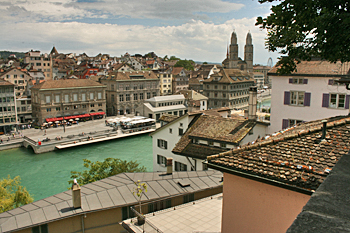
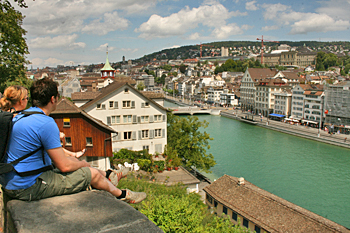
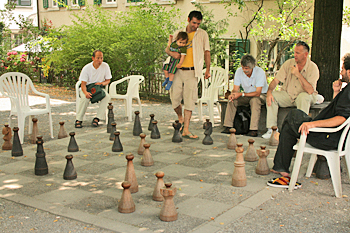
As I made my way back to my hostel for the night I mused on Switzerland, and on Zurich specifically. Everything works here, and works well. I have no complaints in that department. Everything is very efficient. But the people seem cold to me. No one was particularly rude to me. It’s just that I find their manner to be abrupt, as if I am an imposition on their time. Of all the countries I have visited, Switzerland makes the least effort with the English language. It’s not that they don’t speak English – quite the opposite – I found that most everyone speaks at least a little English. It’s just that they do not LIKE to speak English, and if you do not understand what they are saying, they get irritated. I wonder if all this efficiency has resulted in a cold, impersonal lifestyle.
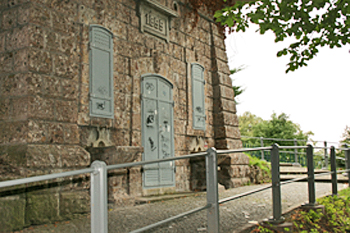
I did, however, spot one chink in the pristine armor of the Swiss. Graffiti is everywhere; on block fences, on the roll-down metal doors of stores, even on the trains themselves. Perhaps this is a sign of the youth rebelling against the cold, impassive Swiss society, although strangely, there seems to be a code of conduct even here – I saw no graffiti on the bricks or blocks of historic buildings. At one stone castle the graffiti was limited to its metal gate – obviously something that could easily be painted over. How efficient.

Barb,
The photographs are terrific–and the text of your adventures. Am so glad you are getting to take this fabulous journey–you deserve it, friend!
With love, Katherine